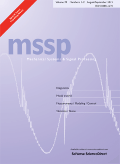Discrete Fourier transform
The subject of the papers in this section is the discrete Fourier transform.
The first paper describes a set of permutations that commute with the discrete Fourier transform. In other words, let x be a signal, and X its DFT. The permutations described in the paper have the following property: if x is permuted, the DFT of the permuted signal can be obtained by permuting the DFT X in a similar way.
 This paper characterizes a potentially useful set of
permutation matrices that commute with the Fourier matrix. The
set of all such permutation matrices is a group under matrix
multiplication, and every element of the group is its own
inverse. The number of these permutations as a function of the
Fourier matrix order is studied. It is shown that it is a
multiplicative function of the Fourier matrix size N.
This paper characterizes a potentially useful set of
permutation matrices that commute with the Fourier matrix. The
set of all such permutation matrices is a group under matrix
multiplication, and every element of the group is its own
inverse. The number of these permutations as a function of the
Fourier matrix order is studied. It is shown that it is a
multiplicative function of the Fourier matrix size N.
How many such permutations exist? Express N as a product of primes,
The number of permutations is 2r, if k0 is zero or one, or 2r+1, if k0 is two, or 2r+2, if k0 is greater than or equal to three.
